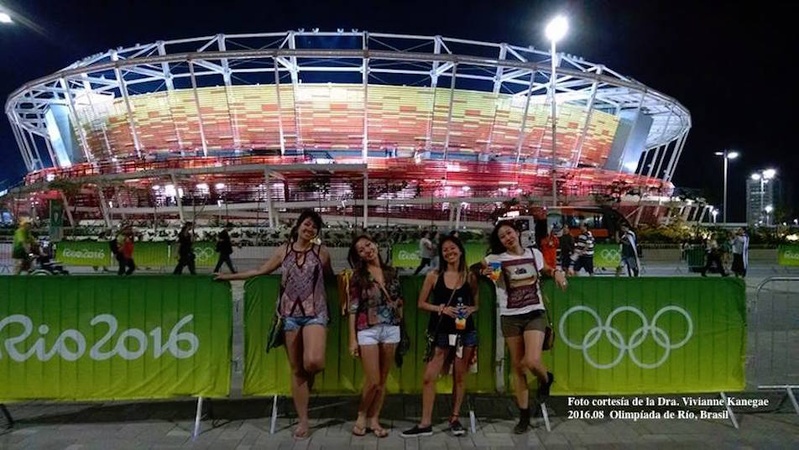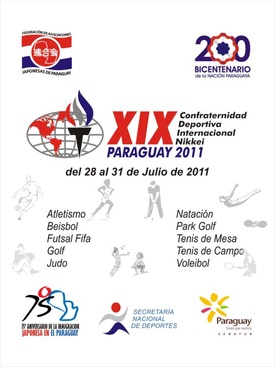At the 2016 Rio Olympics, the local Japanese community supported Japan in various ways. Not only did they provide medical support1 and volunteer guidance for the thousands of Japanese spectators who came to Brazil, but they also cheered on the Japanese athletes at each event, even preparing carp streamers for the women's marathon. Behind the scenes, the official mascots, Vinicius and Tom, were created by Luciana Eguchi, a Japanese Brazilian, and the torch for the Olympic torch relay was designed by Homey Hayashi, a Japanese Brazilian. Meanwhile, two Japanese Brazilians won bronze medals as Olympic athletes: Arturo Oyakawa Mariano in the men's floor exercise gymnastics event, and Poliana Okimoto in the women's 10km open water swimming event. They also worked as coaches and judges for some events for the Brazilian national team.
When an athlete or someone involved in the Olympics has a Japanese surname, it is not only a happy occasion, but it also often attracts attention from some of the media, who explain the circumstances behind it.
Brazil has the largest number of Japanese immigrants in the world, numbering 1.6 million, and next year will mark the 110th anniversary of Japanese immigration. There are many third- and fourth-generation Japanese immigrants, and the proportion of mixed-race immigrants is quite high. Although the number of Japanese immigrants who can speak Japanese is decreasing, their feelings and admiration for Japan, and their desire to study abroad are on the contrary getting stronger.
The relationship between Japanese people and sports dates back to the Japanese immigrants, and in the process of forming a community, when Japanese language schools were established, sports days for children became a major catalyst. Baseball, sumo, volleyball, table tennis, etc. are typical sports in Japanese communities, and these activities also helped to strengthen unity and cooperation within the Japanese community.
In fact, I also started playing baseball, volleyball, and table tennis in my childhood and youth with the local Japanese community. My coach was either a classmate's father or a senior who was an all-around athlete, and thanks to the great efforts of the parents' association, I was able to participate in tournaments in the state. At the time, I would read the manga "Star of the Giants" that was published in the Weekly Shonen Magazine that would occasionally arrive from Japan, and fantasized about becoming as good as pitcher Hikaru Hoshi. I also admired the Giants' players Sadaharu Oh and Nagashima. However, we didn't have any gloves or balls, and all of our equipment was handmade at first. Gradually, we started to get second-hand equipment, and it wasn't until the mid-1970s that we finally got a brand new glove, given to us by a relative in Japan. The same went for our table tennis racket. I still can't forget the joy I felt at that time. Our team wasn't very strong, but by participating in friendly matches with nearby Japanese association teams and regional tournaments, we gradually began to achieve good results. In the league, I played against the youth team of a foreign company in Buenos Aires and the baseball team of a prestigious soccer club, but I don't remember winning much. As for table tennis, my achievements allowed me to be ranked excellent or in the top ranks at local Argentine schools in junior high and high school, and I was able to leave a certain amount of accomplishment.
Argentina, like Brazil and Paraguay, is a soccer powerhouse, but competing with local players on an equal footing was too physically difficult for us. However, in sports like table tennis and handball, even if you are not big, you can be quite successful if you are dexterous, maneuverable, and quick-witted. So when we win a local town or regional tournament and bring the trophy back to school, even small-sized Japanese can become heroes in an instant. These experiences became a great opportunity for us to make our presence known not only to our classmates, but also to the local community.
In any sport, when Japanese people achieve success in national or international tournaments, it naturally becomes a source of pride for the entire society. It can also be a means of fighting discrimination and prejudice in any political situation. "Asahi in Vancouver 2 " (Toho, Fuji TV 55th Anniversary Film), released in 2014, is a story of Japanese people and the local community in Vancouver, Canada, before the war, and is a story of fighting friction and prejudice through baseball, and is based on a true story. The Japanese team, which cannot beat the local team in terms of ability or physique, eventually wins the regional championship by succumbing to bunts and stealing bases, and in the process, anti-Japanese sentiment and the way Canadians look at them change slightly. However, this victory does not mean that all rights are respected or equal opportunities for work and higher education are achieved. Furthermore, thanks to their achievements in baseball, Japanese people continued to live their lives as usual, avoiding friction, and taking great care not to encourage jealousy. Unfortunately, with the outbreak of war they were designated as unwanted aliens, their property confiscated, and they were forcibly sent to internment camps or repatriated to Japan.
In South America, as Japanese immigrants became successful in agriculture and business, and as second-generation Japanese immigrants entered top universities and graduated at the top of their class, jealousy spread and they started to attract resentment. In Peru, many Japanese immigrants were arrested during the war, forced to give up their stores and farmland, and sent to internment camps in the United States, but after the war, from the 1950s, second-generation Japanese immigrants made a great impact in soccer and other sports. Unlike Brazil and Argentina, Peru was not a very strong soccer country, but Japanese players began to join prestigious professional teams (Unión Huaral, Universitario de Deportes, Alianza Lima, etc.) and made great achievements until the 1980s. Daniel, one of the Luis La Rosa brothers, was the top scorer for three consecutive years, and Jaime became a Peruvian representative player at the 1960 Rome Olympics. Pedro (nicknamed "Pedrito") contributed to the victory of every team, and in 1975 he made a major contribution to Peru's victory in the South American championship, the Copa America. In the 70s, Jorge "Coqui" Hirano Matsumoto was a big star for La Paz, Bolivia. He is the Peruvian footballer who has scored the most goals overseas.
When a Japanese athlete becomes a member of a team representing his/her country, the effect is outstanding, and the contributions of the Japanese athlete are recognized by the alma mater, local residents, sports federations, and the whole society. It is very noticeable and becomes a topic of conversation. However, it is important not to become arrogant here, and the most important thing is to humbly celebrate the achievement, and furthermore, to give back to society by nurturing new talent as a coach or manager.
Since the prewar immigration, they have played a similar role in judo and karate, and when a local non-Japanese athlete becomes famous, there is almost always a Japanese or Japanese instructor behind the athlete. There are also many Japanese who have taught martial arts and combat sports in the police and military.
Currently, in many countries, the third and fourth generation of Japanese descendants are becoming the main generation, but in the Japanese communities of Latin America, a Japanese sports tournament called "Confraternidad Nikkei" is held every two years. Participating countries send as many athletes as possible to the host country to compete in several sports. The name of the tournament, "Confraternidad," has a strong connotation of goodwill and friendship. Although it is a tournament within Latin America, it used to be difficult to realize such a project because of the high travel expenses, but it has been actively held for the past 20 years, and it will be held in Santa Cruz, Bolivia in 2014, Mexico in 2016, and Chile, where there are said to be 3,000 Japanese descendants, in 2018. Each country spends two years raising funds through various projects, and as the host country, with the full cooperation of the parents of the participating athletes, they wait for many Japanese descendants to participate. If Japanese high school and university students can eventually participate in these tournaments, it will be a great inspiration for the Japanese communities in South America and will undoubtedly lead to an improvement in the level of competition.
Baseball is a minor sport in many South American countries, but in recent years, Japanese youth baseball teams have come to Japan to participate in several tournaments. In addition, in Argentina, a team from the University of Hyogo is helping out with training camps as part of a JICA project.4

In times of peace, such exchanges and strengthening support projects are possible, but in times of peace or after conflict, sports are almost always used as a breakthrough to restart exchanges. For Nikkei, strengthening ties within the community was previously the aim, but now exchanges within the region and with Japan are a major goal.
Notes:
1. " Santa Cruz Hospital to send doctors to Rio Olympics, Japanese-speaking doctors available 24 hours a day, toll-free telephone line also set up for patient reception " (July 22, 2016, Nikkei Shimbun)
2. This is the official website for the work " Vancouver Sunrise ."
3. " Jorge Hirano: Kamikaze on the Altiplano " (DeChalaca.com, October 10, 2008) [Spanish only]
For information on the achievements of Japanese-Peruvian players, see " Japanese-Peruvian Soccer Players: A Story Enthralled by the Ball " (March 15, 2017, Discover Nikkei).
4. This is an international sports contribution project called "Sports for Tomorrow" and is being implemented by JICA. The La Plata Japanese team in Buenos Aires is a selected member of the team and is the recipient of this support, and they also play practice matches in Japan.
" Memorandum of Understanding signed with University of Hyogo to promote volunteer activities " (September 2, 2014, JICA)
© 2017 Alberto Matsumoto








